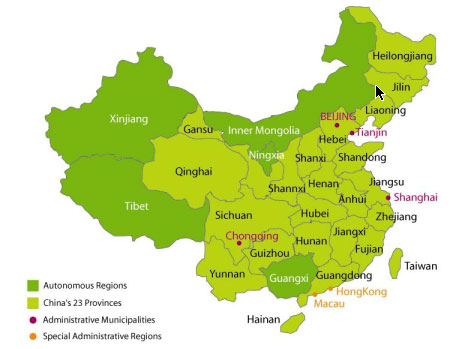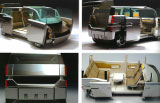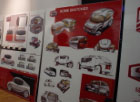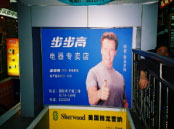 |


![]()
> archived articles
> write for core
|
The Top 10 Myths & Truths about Design in China |
|||||||||||||||||||||||||||||||||||||||||||||||||
|
You have never been to China but heard about China's staggering GDP growth rate of 9.1%* and its emerging 1.3 billion people market (almost 5 times the size of the U.S. population). You have read in Business Week or design magazines about all the hype in China, but what's the real truth? What you should know about Design in China? * Source- IMF World Economic Outlook 2003 Report Top 10 Myths and Truths about Design in China
Myth 1: All design jobs are going to China Truth: Yes and no. There are two parts to this answer; it very much depends on what type of "design" one is referring to. DESIGN is a very big word, from designing a corporate brand strategy, designing an innovative way of cleaning, or designing the styling of a toothbrush—we all call it "design." 1) The bad news is if you are in the last category of "design"—product form-making or styling business—it is very likely that such design services will truly move to China. Clients who are in the business of supplying distribution channels with loads of different styles of products—who are mainly looking for product "re-packaging" with quick turn around time—might find product sketching and rendering skills in China already very sophisticated and cost-effective [Figure 1, 2, 3]. China also has the location advantage of providing one-stop-shop service, from design rendering, engineering to manufacturing, so clients know that the designs on paper can be manufactured.
2) The other side of the story is that good design sketching and rendering skills do not necessarily equate to innovation and creativity. China's education system has traditionally placed much emphasis on examinations, and teaching methods tend to be one-way-street lectures (teacher teaches, students listen and follow directions). Students are also not encouraged to ask questions or challenge opinions which stifles creative thinking. In addition, China as a conformist society, and its cultural tradition of respecting hierarchy and seniority makes it difficult for design cultures to operate in a flat organizational structure emphasizing equal status and teamwork. China's design schools also have an inherent culture of in-breeding, hiring design graduates to become design professors. This phenomenon is very typical, as "trust" is very much placed on established relationships, hindering the diversity of culture and backgrounds. However, it is worth noting that China's design industry is also in a rapid state of growth. China has more than 400 design schools to date, and in the past few years, there have been many international design conferences, lectures and workshops organized in China, attracting speakers from all over the world. Although it might take time for ideas to germinate and ways of working to change, in China, the state of the design industry will not remain the same. Designers in the U.S. need to quickly engage in more strategic levels of design, and to create innovations that revolutionize businesses. The bright side is you will no longer have to convince your clients of the importance of strategic design and innovation when China corporations can produce a mature product at one-fifth of the price. It is now a requirement for businesses to engage in innovation, rather than the "when we have the money to spare on design"-type of business environment they are used to. Innovate or die. Myth 2: China designers are giving away designs for nothing Truth: How much does a McDonald's burger cost in the U.S.? USD 99 cents. How many Chinese buns can one U.S. dollar buy in China? Probably eight or more, depending on which city you are in. The same amount of money in the U.S. might not exchange for the same amount of goods and services in China. What foreigners might not understand is that there is a vast difference in standards of living between U.S. and China. A USD$300 design job in the U.S. (a few hours worth of design consulting fees) might equal a month's salary for an entry level designer in Shanghai. So working for USD$300 in China does not constitute "underbidding" or "working for nothing." The truth is, if you live in China, your U.S. salary can last you a very long time—depending, of course, on your lifestyle.Myth 3: China is ONE homogenous market of 1.3 billion people
 Figure 7: China's 23 provinces, autonomous regions, administrative municipalities and Special Administrative Regions (SAR). Myth 4: China's market is in Beijing & Shanghai Truth: Major cities in China like Beijing and Shanghai might be the focal points, dominating foreigner's perception of the emerging markets in China. But as mentioned above, China is not one homogeneous market. Unlike in the U.S., China's economic growth is largely determined by governmental policies. Shanghai, Beijing, Tianjin and Chongqing were designated to be administrative municipalities, and cities such as Hong Kong and Macau (recently returned to China) have also been designated as Special Administrative Regions (SAR), all enjoying policies of economic advantages—a favoritism governmental policy might not necessarily be understood from the outside. China, still a planned-economy on the political front has recently designated 9 economic zones: 1. South China Region (HK, Macau, Guangdong…) 2. Lower Reaches of Yangtze River Area (Shanghai, Jiangsu…) 3. North China (Beijing, Tianjin…) 4. North East China ( Jilin, Liaoning… ) 5. Middle and Lower Reaches of Yellow River Area (Shanxi, Henan…) 6. Middle South Area (Hubei, Hunan… ) 7. South West Area (Yunnan, Sichuan… ) 8. North West Area (Gansu, Qinghai, Ningxia… ) 9. Fujian and Taiwan Area China's market should be tackled through understanding its governmental policies on economic development for different regions. Depending on what your business is, different policies in different regions in China might be more favorable to your business. China's governmental policies have profound effects on people's behavior, influencing product strategies and designs for the China market. For example, in the 1980s, as a result of China's Open Door Policy, Shenzhen was the first city to be "opened," which induced a massive migration of young talent to the south of China to pursue job opportunities. Myth 5: China's market can be tackled remotely Truth: China's market as a developing country is moving rapidly; the rate of growth is extremely fast. Its middle class, although comprising only 5% of China's entire population in 2003, is growing at a rate of 1% per year. That 1% represents 13 million people per year—twice the population New York! A two-year R&D development time for the China market means that your market data and information could become obsolete before the product hits the China shore. Moreover, if your client or business intends to sell products in China, or to design products for its consumers, it will be almost impossible to understand the intricacies of its social, cultural and political constructs without actually being there. The Chinese have a proverb: "Fishing across the mountains," meaning that it is hard to get anything done where distance is in the way. Just as it is impossible for Mainland designers to design products for American users without ever crossing the Pacific Ocean, it is also hard for U.S. designers to design for the China market without ever being in China to know what life is like there." Myth 6: Localization means Chinese translation Truth: Many imported products in China are merely duplications of its successful counterpart in its home country with product features directly translated into Chinese. Products directly implanted into the China market have 2 major risks: 1) Incomprehensible translation—as certain concepts are not directly translatable in another language and need reconceptualizing e.g. Microsoft Windows translated into Chinese does not carry the same metaphoric meaning of "windows to the world." And its desktop icon "My Windows" sounds quite silly in Chinese. 2) Certain foreign products might not even be designed appropriately or suitably for the needs of China's market (e.g. dishwashers, which are not a common household appliance in China).
Myth 7: China does not have its own brands Truth: Perhaps the most well known China brand internationally is Tsing Dao Beer. There might be a common perception that China is a "World Factory," with a low-cost labor force and a focus on OEM business. There are, in fact, many major internal brands in China that people outside of the country might not be aware of [Figure 9]. These brands have mainly catered to China's internal market or products sold to the neighboring countries of India and Russia. Major internal brands in China that earn over 1.25 billion U.S. dollars annually include: Haier, TCL, Lenovo, Midea, SVA etc.*** In certain categories of house hold appliances, Mainland users are starting to shift from purchasing foreign brands to buying internal Mainland brands, as product quality is similar but price is much lower than those of foreign imported goods. With China's recent accession into the WTO, Mainland brands are also starting to find channels into the international market and finding ways to improve their product designs or reinvent their product lines.
Source- The Ministry of Information Industry of PRC 2001 (TOP 100 Electronics Enterprises in China) Myth 8: A great product will speak for itself in China Truth: A common misperception is that selling a product in China is much the same as selling a product in the U.S. If you have been to China and seen billboards all over the place, you will notice that in almost all categories of products and services, from fast food, cosmetics and apparel, to home appliances, office products, apartments and hotels, will inevitably have famous celebrities or prominent public figures advertising for them [Figure 10, 11, 12]. What's more, the person can be entirely unrelated to the product. As China is a people-oriented society, a trusted spokesperson for a product will win miles over a great design without the word of mouth from trusted sources.
Myth 9: Time equals to money in China Truth: It is common practice for design consultancies in the U.S. to charge on an hourly rate basis, like a taxi meter. Where time equates to money in the U.S., the same might not apply in China. First, there is the difference in value assigned to tangible goods versus intangible goods. If you had the experience working in China, you might find that intangible goods such as services, intellectual property, concepts and ideas might not be readily received as having more monetary value than tangible goods such as buildings and products. As China is still mainly an industrial-based economy, tangible goods are thought of as having greater value than intangible goods. Also, with the history of a planned economy, everything in China was once assigned top-down by the government: from where people work and where they live to what people do. Certain concepts and expectations that are a norm in a capitalistic society, such as offering competitive rates and services, or having definite timeframes and deadlines to deliver goods, cannot be immediately assumed in a country where people lead a very different life. When you are used to a model of being taken care of by the government in all aspects of life—where it is not necessary to compete to earn a living—the concept of time and pace of life can be very different. Since China opened up in the 1980s, however, the country is changing fast. So depending on the age group, thought models can vary. Myth 10: Business success in China is by done via optimizing operational efficiency, cost-effectiveness and gaining market share. Truth: Business in China is not be perceived as solely a transaction of money and time. In the U.S., the concept of friendship and business is separate. However, in China, to do business, one has to first become a trusted friend. This perceptual difference can cause much frustration when doing business in China, as foreigners often want to get down to business right away on their first encounter—signing the contract, setting the deadlines and deliverables—while the Chinese counterpart might get offended at the perceived overly-aggressive behavior, shutting all doors without explaining why. As mentioned earlier, culturally, under the Chinese education system, people are not trained to actively raise questions to clarify situations. Plus, there are a lot of established Chinese cultural and social protocols, where Chinese people have certain expectations of appropriate behaviors that might not be spoken out explicitly, but expect the other party to perform nonetheless. The good news is that once a trusting relationship is established, it can be a long-term engagement where clients might not be tempted to switch to lower-priced competitors or hire different companies to try out fresh ideas. So the advice is: patience, patience and patience. Designer's survival kit in China: 1. Learn PuTongHua Do not assume that English is the international business language in China. If you are lucky, you might work with Mainland Chinese people who speaks English. Even then, do not automatically assume that Mainland Chinese speaking English will mean that they understand you conceptually. Often times, miscommunication arises when you think the other party understands you—but they really don't—and are culturally resistant to ask clarifying questions. If you are in the food chain where you need to travel to China to either oversee manufacturing in China or design for the China market, it is a good idea to learn the Chinese national language: PuTongHua. Your Chinese associates will be taken by surprise, and this will move you miles ahead in the game. For a good start, when meeting someone new, say: "Ni hao ma," meaning "How are you?" 2. See China for yourself If you have never been to China but your work is inseparable from China, take some advice from a traditional Chinese proverb: "Rather than read ten thousand pages of a book, its better to walk ten thousand miles." Fear is driven by "not knowing." Be there and see China for yourself. Your perception of China could very well be tinted by the media, and the China experience could be way beyond your expectations. (There are no "fortune cookies" in China, by the way.) 3. "Do as the Romans Do" In China, the rules of the game are different. What works in the U.S. might not apply to China, and insisting on how things should work in another culture is not a very good idea. Immersing yourself into the culture, you might find that certain concepts that you take for granted—such as perception of time, concept of money, philosophical world-view, policies, concept of law—are not the same in China. One has to understand that working in China is not only working in another country, it's also working in another culture that has a history steeped in a very different political system based on a planned economy with state-driven policies. Working against the grain will only frustrate foreign companies, pushing them to retreat. 4. Find a blind man's stick If operating in China is too much of a mystery to you, or way too much of a headache, it pays to find people who can act as a bridge for you, communicating both ways culturally and linguistically. It will save you a lot of time and energy running into barriers of cultural and language differences. Do you think a Chinese designer who has never been to the U.S. can understand the U.S. market better then a U.S. designer? The same applies the other way round. Hire reliable professionals who are at the pulse of the market and have a better understanding of China on the ground level. Elaine Ann is the founder of Kaizor Innovation, a strategic innovation company based in Hong Kong, offering innovation strategies and design/user research to companies targeting to the emerging China market. Bi-cultural and bilingual, she has lived and worked in the U.S. for 12 years (for companies such as Fitch Worldwide, Razorfish, Henry Dreyfuss, and Philips Design.) Her company provides unique insights that bridge behavioral, cultural, social and political differences between markets. Elaine brings to Asia processes of new product innovation and user-centered design methodologies. For more information about Kaizor Innovation, email info@kaizor.com or visit www.kaizor.com. A member of the Red Network at www.red-net.org.
|
|||||||||||||||||||||||||||||||||||||||||||||||||











